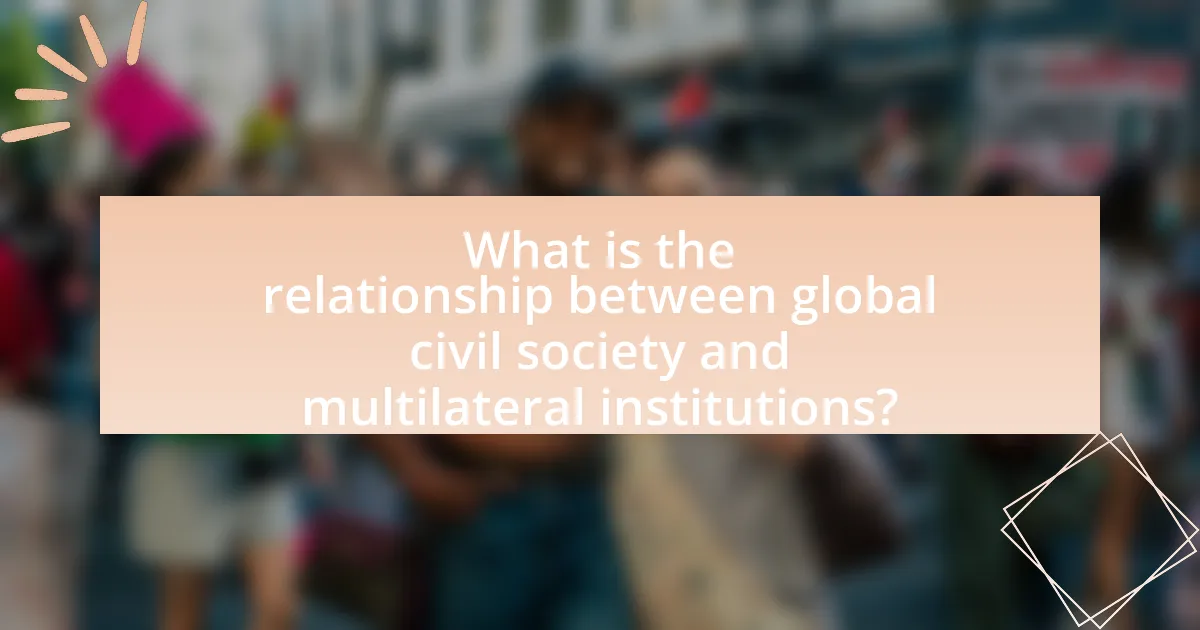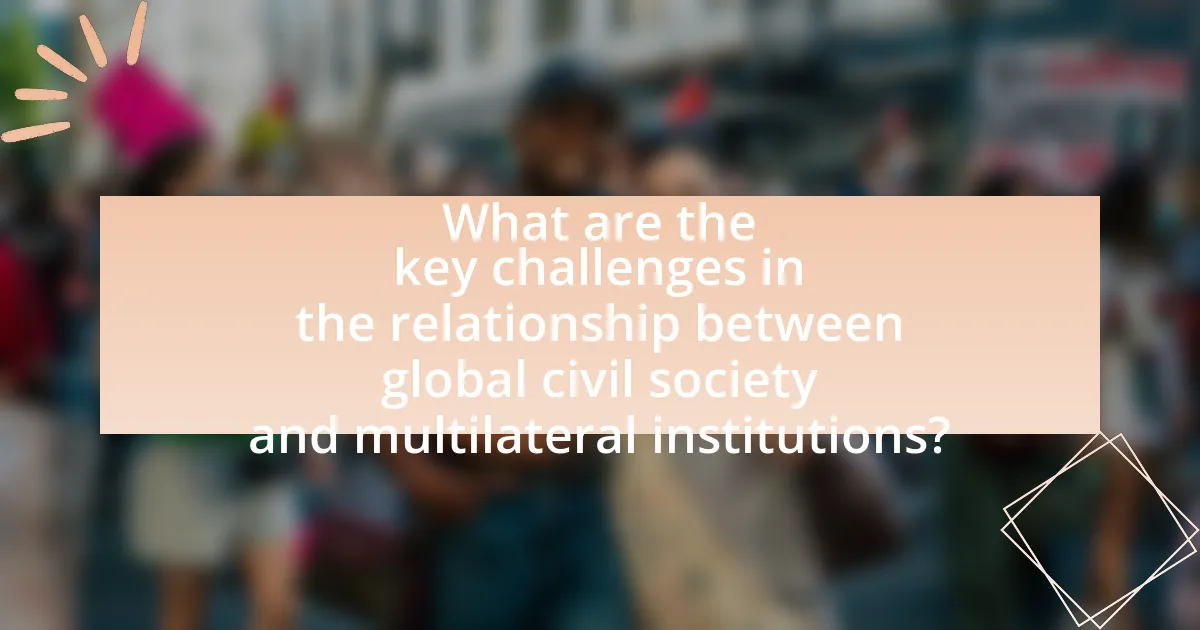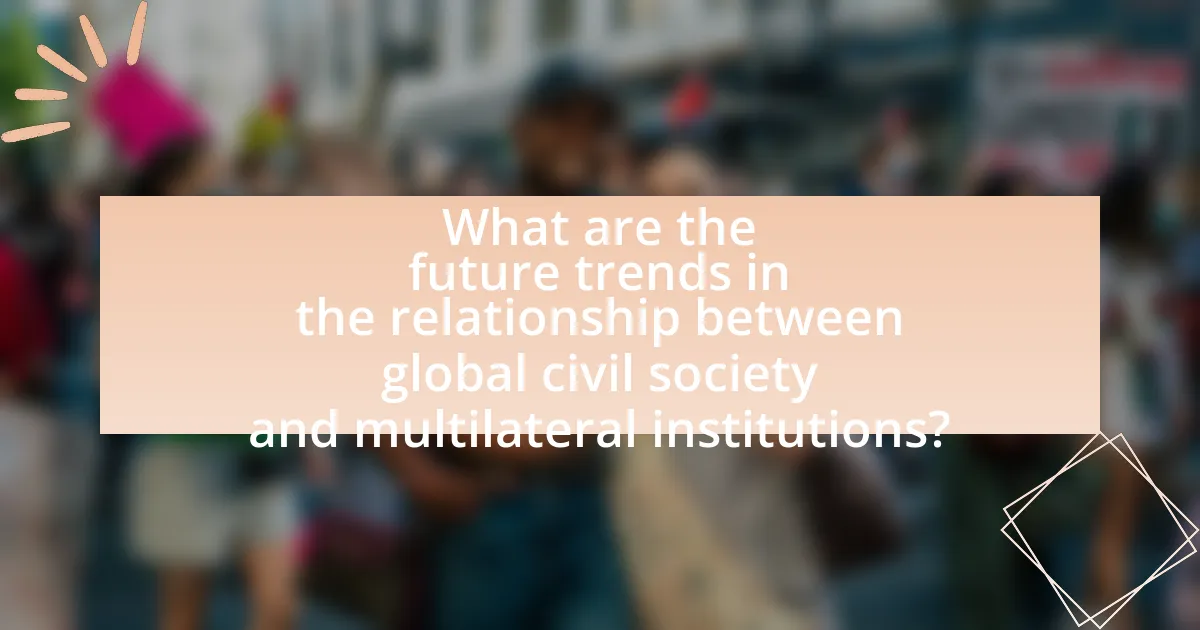The article examines the intricate relationship between global civil society and multilateral institutions, highlighting how non-governmental organizations, advocacy groups, and social movements influence international policies and practices. It discusses the mechanisms of interaction, including advocacy, collaboration, and policy influence, while emphasizing the critical roles these civil society organizations play in representing marginalized voices and holding governments accountable. Additionally, the article addresses the challenges faced by civil society in engaging with multilateral institutions, such as limited representation and resource constraints, and explores strategies for enhancing collaboration and improving engagement. Finally, it outlines future trends, including the impact of technology and digital activism on this relationship, and presents successful examples of collaboration that inform best practices for future partnerships.

What is the relationship between global civil society and multilateral institutions?
Global civil society and multilateral institutions are interconnected, as global civil society often influences the policies and practices of multilateral institutions. Global civil society comprises non-governmental organizations, advocacy groups, and social movements that engage in dialogue and action on global issues. These entities contribute to shaping international norms and policies by providing expertise, mobilizing public opinion, and holding institutions accountable. For instance, organizations like Amnesty International and Greenpeace have successfully lobbied multilateral institutions such as the United Nations to adopt resolutions on human rights and environmental protection. This relationship highlights the role of civil society in enhancing the legitimacy and responsiveness of multilateral institutions in addressing global challenges.
How do global civil society and multilateral institutions interact?
Global civil society and multilateral institutions interact through advocacy, collaboration, and policy influence. Global civil society organizations often engage with multilateral institutions, such as the United Nations, to promote human rights, environmental sustainability, and social justice. For instance, during the 2015 Paris Agreement negotiations, numerous civil society groups played a crucial role in shaping climate policy by providing research, mobilizing public opinion, and holding governments accountable. This interaction enhances the legitimacy and effectiveness of multilateral institutions by incorporating diverse perspectives and expertise, ultimately leading to more comprehensive and inclusive global governance.
What roles do global civil society organizations play in multilateral institutions?
Global civil society organizations play critical roles in multilateral institutions by advocating for policy changes, representing marginalized voices, and holding governments accountable. These organizations engage in lobbying efforts to influence international agreements and decisions, as seen in the role of NGOs during the United Nations Climate Change Conferences, where they push for stronger environmental protections. Additionally, they provide expertise and research that inform policy-making, exemplified by organizations like Amnesty International, which contributes to discussions on human rights standards. Their participation enhances transparency and inclusivity within multilateral processes, ensuring that diverse perspectives are considered in global governance.
How do multilateral institutions influence global civil society?
Multilateral institutions influence global civil society by providing platforms for dialogue, setting international norms, and facilitating cooperation among states and non-state actors. These institutions, such as the United Nations and the World Bank, create frameworks that empower civil society organizations to engage in policy-making processes, advocate for human rights, and promote sustainable development. For instance, the UN’s Sustainable Development Goals encourage civil society participation in achieving global objectives, thereby enhancing their visibility and impact. Additionally, multilateral institutions often allocate funding and resources to civil society initiatives, further strengthening their capacity to address global challenges.
Why is the relationship between global civil society and multilateral institutions important?
The relationship between global civil society and multilateral institutions is important because it enhances democratic governance and accountability on a global scale. Global civil society organizations, such as NGOs and advocacy groups, play a crucial role in representing diverse perspectives and interests, thereby influencing policy decisions made by multilateral institutions like the United Nations and the World Bank. For instance, the inclusion of civil society in the UN’s Sustainable Development Goals process ensured that the voices of marginalized communities were heard, leading to more equitable and effective policies. This collaboration fosters transparency, encourages public participation, and ultimately strengthens the legitimacy of multilateral institutions in addressing global challenges.
What impact does this relationship have on global governance?
The relationship between global civil society and multilateral institutions significantly enhances global governance by promoting accountability, transparency, and inclusivity in decision-making processes. This dynamic allows civil society organizations to advocate for diverse perspectives and hold institutions accountable, thereby improving policy outcomes. For instance, the involvement of civil society in the United Nations’ Sustainable Development Goals has led to more comprehensive approaches that consider the needs of marginalized communities, demonstrating how civil society can influence multilateral agendas effectively.
How does this relationship affect policy-making at the international level?
The relationship between global civil society and multilateral institutions significantly influences policy-making at the international level by enhancing accountability and promoting diverse perspectives. Global civil society organizations advocate for issues such as human rights, environmental protection, and social justice, which can lead to the incorporation of these concerns into international agreements and policies. For instance, the involvement of NGOs in the United Nations Framework Convention on Climate Change has resulted in stronger commitments from member states to address climate change, reflecting the demands of civil society. This dynamic fosters a more inclusive policy-making process, ensuring that a wider range of voices is considered in the development of international norms and regulations.

What are the key challenges in the relationship between global civil society and multilateral institutions?
The key challenges in the relationship between global civil society and multilateral institutions include a lack of representation, differing priorities, and limited resources. Global civil society often feels underrepresented in decision-making processes within multilateral institutions, which can lead to a disconnect between the needs of local communities and the policies enacted at the global level. Additionally, multilateral institutions may prioritize state interests or economic growth over social justice and human rights, creating tension with civil society organizations that advocate for these issues. Furthermore, many civil society organizations face resource constraints, limiting their ability to engage effectively with multilateral institutions and influence policy outcomes. These challenges hinder collaboration and the potential for meaningful dialogue between the two entities.
What obstacles do global civil society organizations face in engaging with multilateral institutions?
Global civil society organizations face significant obstacles in engaging with multilateral institutions, primarily due to limited access to decision-making processes. These organizations often encounter bureaucratic barriers that restrict their participation in discussions and negotiations, as seen in the United Nations where only accredited entities can influence policy. Additionally, funding constraints hinder their ability to sustain advocacy efforts and mobilize resources effectively. A report by the International Council for Human Rights Policy highlights that many civil society groups lack the financial backing necessary to engage consistently with multilateral forums, which diminishes their impact. Furthermore, political resistance from member states can marginalize the voices of civil society, as governments may prioritize national interests over global collaboration, limiting the effectiveness of these organizations in influencing multilateral outcomes.
How do power dynamics affect the participation of civil society in multilateral processes?
Power dynamics significantly influence the participation of civil society in multilateral processes by determining the access and influence that these organizations have in decision-making arenas. Dominant states and powerful institutions often shape the agenda, sidelining less influential civil society groups, which can lead to unequal representation and limited engagement opportunities. For instance, research by the United Nations Development Programme highlights that civil society organizations from developing countries frequently face barriers such as lack of funding and limited networking opportunities, which restrict their ability to participate effectively in multilateral discussions. This imbalance in power dynamics can result in policies that do not adequately reflect the needs and perspectives of marginalized communities, thereby undermining the overall effectiveness of multilateral agreements.
What are the limitations of multilateral institutions in addressing civil society concerns?
Multilateral institutions face significant limitations in addressing civil society concerns primarily due to their bureaucratic structures and the need for consensus among member states. These institutions often prioritize state sovereignty and diplomatic relations over grassroots issues, which can lead to a disconnect from the actual needs of civil society. For instance, the United Nations, while it has mechanisms for civil society engagement, often struggles to incorporate diverse voices due to its reliance on member states to represent their populations. Additionally, funding constraints and political agendas can limit the effectiveness of initiatives aimed at addressing civil society issues. Reports indicate that only a fraction of civil society organizations receive adequate support from these institutions, highlighting the gap between institutional capabilities and civil society needs.
How can these challenges be addressed?
To address the challenges between global civil society and multilateral institutions, enhancing collaboration and communication is essential. Establishing formal channels for dialogue allows civil society organizations to contribute their perspectives and expertise, which can lead to more inclusive decision-making processes. For instance, the United Nations has initiated partnerships with civil society through mechanisms like the Civil Society Unit, which facilitates engagement and input from various stakeholders. This approach not only empowers civil society but also enriches the policy-making process by integrating diverse viewpoints, ultimately leading to more effective and representative outcomes.
What strategies can global civil society employ to enhance their influence in multilateral institutions?
Global civil society can enhance their influence in multilateral institutions by employing strategies such as coalition-building, advocacy, and leveraging technology. Coalition-building allows diverse organizations to unite around common goals, amplifying their collective voice and increasing their negotiating power. For instance, the Global Campaign for Education successfully united various NGOs to influence education policies at the United Nations, demonstrating the effectiveness of this strategy. Advocacy efforts, including targeted lobbying and public campaigns, can raise awareness and pressure decision-makers to consider civil society perspectives. The use of technology, such as social media and online platforms, enables civil society groups to mobilize support, disseminate information rapidly, and engage a broader audience, as seen in movements like #MeToo, which influenced global discussions on gender equality. These strategies collectively enhance the capacity of global civil society to impact multilateral decision-making processes.
How can multilateral institutions improve their engagement with civil society?
Multilateral institutions can improve their engagement with civil society by establishing structured dialogue mechanisms that facilitate regular communication and feedback. For instance, the United Nations has implemented multi-stakeholder forums that allow civil society organizations to present their perspectives and contribute to policy discussions, enhancing transparency and inclusivity. Research indicates that such engagement leads to more effective policy outcomes, as evidenced by the increased participation of civil society in the Sustainable Development Goals process, which has resulted in broader public support and accountability.

What are the future trends in the relationship between global civil society and multilateral institutions?
Future trends in the relationship between global civil society and multilateral institutions indicate an increasing collaboration driven by shared goals such as climate action, human rights, and sustainable development. This trend is evidenced by the growing influence of civil society organizations in shaping international policies, as seen in the Paris Agreement, where NGOs played a crucial role in advocacy and mobilization. Additionally, multilateral institutions are increasingly recognizing the importance of civil society input in decision-making processes, leading to more inclusive governance structures. This shift is supported by initiatives like the United Nations’ Sustainable Development Goals, which emphasize partnerships with civil society to achieve global objectives.
How is the role of technology changing this relationship?
Technology is transforming the relationship between global civil society and multilateral institutions by enhancing communication, increasing transparency, and facilitating grassroots mobilization. Digital platforms enable civil society organizations to disseminate information rapidly, engage with a broader audience, and advocate for policy changes more effectively. For instance, social media campaigns have successfully influenced international agendas, as seen in movements like #MeToo and climate activism, which have garnered global attention and prompted responses from multilateral institutions. Furthermore, technology fosters greater accountability by allowing citizens to monitor and report on the actions of these institutions, thereby strengthening democratic governance and participation.
What impact does digital activism have on global civil society’s engagement with multilateral institutions?
Digital activism significantly enhances global civil society’s engagement with multilateral institutions by facilitating communication, mobilization, and advocacy efforts. This engagement is evidenced by the rise of online campaigns that influence policy discussions and decision-making processes within organizations like the United Nations and the World Health Organization. For instance, the #MeToo movement utilized social media to raise awareness about gender-based violence, prompting multilateral institutions to address these issues in their agendas. Additionally, digital platforms allow civil society organizations to gather support and resources quickly, amplifying their voices in international forums. This shift towards digital activism has led to increased accountability and responsiveness from multilateral institutions, as they are now more accessible to public scrutiny and pressure.
How are multilateral institutions adapting to the rise of digital platforms?
Multilateral institutions are adapting to the rise of digital platforms by enhancing their digital governance frameworks and fostering partnerships with tech companies. For instance, organizations like the United Nations have initiated dialogues on digital cooperation, focusing on issues such as data privacy, cybersecurity, and the ethical use of artificial intelligence. These adaptations are evidenced by the establishment of the UN Secretary-General’s Roadmap for Digital Cooperation, which aims to promote inclusive digital transformation and address the challenges posed by digital platforms. Additionally, multilateral institutions are increasingly engaging with civil society and private sector stakeholders to create policies that reflect the complexities of the digital landscape, ensuring that global governance remains relevant in the face of rapid technological change.
What best practices can enhance collaboration between global civil society and multilateral institutions?
Best practices that can enhance collaboration between global civil society and multilateral institutions include establishing clear communication channels, fostering mutual respect, and engaging in joint initiatives. Clear communication channels facilitate the exchange of information and ideas, ensuring that both parties understand each other’s goals and challenges. Fostering mutual respect builds trust, which is essential for effective collaboration; for instance, recognizing the expertise and contributions of civil society organizations can lead to more inclusive decision-making processes. Engaging in joint initiatives, such as collaborative projects or policy advocacy, allows both entities to leverage their strengths and resources, ultimately leading to more impactful outcomes. These practices are supported by successful partnerships observed in various global initiatives, such as the Sustainable Development Goals, where collaboration between civil society and multilateral institutions has proven effective in addressing complex global challenges.
What successful examples exist of collaboration between these entities?
Successful examples of collaboration between global civil society and multilateral institutions include the partnership between the United Nations and various non-governmental organizations (NGOs) during the Sustainable Development Goals (SDGs) initiative. This collaboration has led to significant advancements in areas such as poverty reduction, gender equality, and climate action. For instance, the UN’s engagement with organizations like Oxfam and Amnesty International has facilitated the implementation of programs that directly address these goals, demonstrating the effectiveness of joint efforts in policy advocacy and grassroots mobilization. Additionally, the World Health Organization’s collaboration with civil society during the COVID-19 pandemic has been pivotal in disseminating accurate information and ensuring equitable access to vaccines, showcasing the critical role that civil society plays in supporting multilateral efforts.
How can lessons learned from past collaborations inform future partnerships?
Lessons learned from past collaborations can significantly inform future partnerships by providing insights into effective strategies and potential pitfalls. Analyzing previous collaborations reveals best practices, such as the importance of clear communication and shared goals, which enhance cooperation. For instance, the collaboration between the United Nations and various NGOs during the Millennium Development Goals initiative demonstrated that aligning objectives and maintaining open dialogue led to successful outcomes. Additionally, understanding past failures, such as the lack of stakeholder engagement in certain initiatives, can guide future partnerships to prioritize inclusivity and transparency. This evidence underscores that leveraging historical experiences fosters stronger, more effective collaborations in the context of global civil society and multilateral institutions.